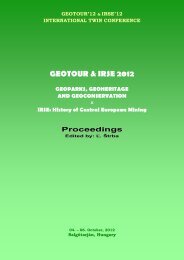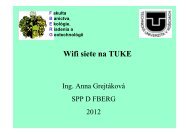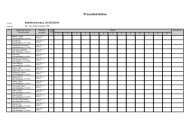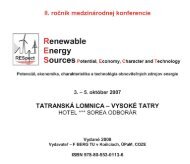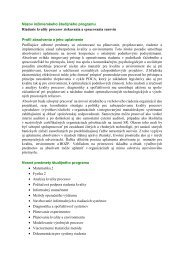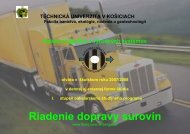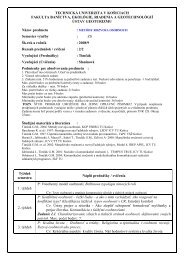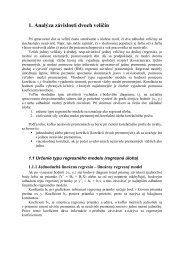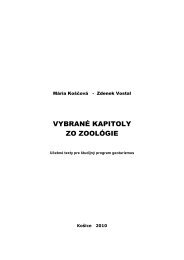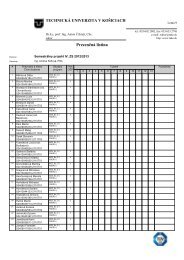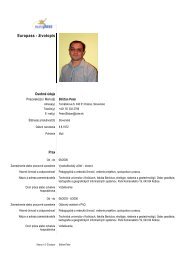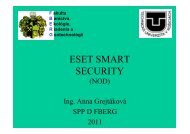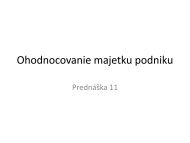GEOTOUR & IRSE 2012.pdf - Fakulta BERG - TUKE
GEOTOUR & IRSE 2012.pdf - Fakulta BERG - TUKE
GEOTOUR & IRSE 2012.pdf - Fakulta BERG - TUKE
Create successful ePaper yourself
Turn your PDF publications into a flip-book with our unique Google optimized e-Paper software.
<strong>GEOTOUR</strong> & <strong>IRSE</strong> 2012<br />
time mostly at the turn of the 40s and 50s of the 20th century, in connection with the search<br />
for uranium ores [17]. In order to exchange experience in the scope of identification and<br />
documentation of such type of objects as well as to spread the results of the conducted work,<br />
the conference “Dziedzictwo i historia górnictwa oraz wykorzystanie pozostałości dawnych<br />
robót górniczych” (Mining heritage and history and making use of remains of former mining<br />
works) is organised every year, starting from 2005. However, the most important effect of the<br />
conducted work seems to be the practical use of their results, as the preparation basis for the<br />
recent project executed by KGHM CUPRUM Sp z o.o., under the title “Rekultywacja<br />
obszarów zdegradowanych działalnością górniczą na terenie Gminy Mirsk, z utworzeniem<br />
ścieżki turystycznej Śladami dawnego górnictwa kruszców” (Reclamation of the regions<br />
degraded by mining activity in the area of Mirsk Commune with the creation of the tourist<br />
path Along the footprints of old ore mining). This project is a model example of how to make<br />
use of scientific and research work that is conducted by the scientific centre - Wrocław<br />
University of Technology, the results of which have turned out to be interesting for practical<br />
point of view and become the subject of interest of the self-government bodies due to the<br />
expected benefits associated with the improvement of the environment condition and<br />
development of the Commune. It is worth stressing that Mirsk Commune representatives were<br />
acquainted with the results of the research and cataloguing work during the conference<br />
“Dziedzictwo i historia górnictwa oraz wykorzystanie pozostałości dawnych robót<br />
górniczych”, which entailed their interest in the scope of the possibilities to make use of the<br />
mining heritage survived in the area of the Commune in the development of industrial tourism<br />
and geo-tourism, and hence to significantly improve the hitherto modest tourist proposal.<br />
In the conditions of Lower Silesia, the project executed on the basis of the described work is<br />
seen as an innovative and piloting project. For the first time, an attempt has been made to save<br />
the complex of historical mining sites dated back in the period from the 16th to 19th century,<br />
in a complex manner. They have been subject to intensive destruction since the 50s of the<br />
20th century, when the exploration works were finally stopped there, and the former workings<br />
have become illegal waste dumps. The research and cataloguing work of the Mining Institute<br />
of the Wrocław University of Technology has become a contribution to the presently<br />
conducted activities aimed to preserve, conserve and economically use the remains of the<br />
former mining sites. The interest aroused by the described interdisciplinary Project among the<br />
self-governing bodies of many Lower Silesian communes in the area of which similar remains<br />
of former mining works are located (as for example in the Świdnica Commune, where the<br />
above-mentioned remains of the former lead and silver ore mines are located) and in the<br />
community of people widely associated with tourism – both those conducting economic<br />
activity and those making use of attractions prepared for visiting, make it possible to assume<br />
that in the near future similar activities will be undertaken in other historical centres of ore<br />
mining and metallurgy in the Sudeten and at their foothills. The remains of several-centuryold<br />
mining activity, properly preserved and made available for visitors, may soon become the<br />
major tourist attraction of Lower Silesia and its symbol on the tourist map of modern-day<br />
Europe.<br />
REFERENCES<br />
[1] CRAIG J.R., VAUGHAN D.J., SKINNER B.J., Zasoby Ziemi, Warszawa 2003.<br />
[2] CZAPLIŃSKI M., KASZUBA E., WĄS G., ŻERELIK R. (ed.), Historia Śląska, Wyd.<br />
Uniw. Wroc., 2002.<br />
[3] DZIEDZIC., K., KOZŁOWSKI S., MAJEROWICZ A., SAWICKI L. (ed.), Surowce<br />
Mineralne Dolnego Śląska, Wrocław 1979.<br />
[4] DZIEKOŃSKI T., Wydobywanie i metalurgia kruszców na Dolnym Śląsku od XIII do<br />
połowy XX w., Wydawnictwo PAN, 1972.<br />
111



